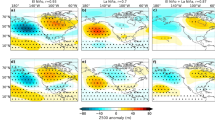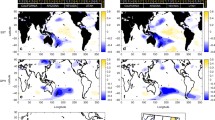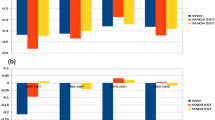Abstract
Cold-air mesocyclones remain a forecasting challenge in the southern hemisphere middle and higher latitudes, where conventional observations are lacking. One way to improve mesocyclone predictability is to determine their larger-scale circulation environments and associations with teleconnection patterns. To help realize this objective, reanalysis datasets on atmospheric and upper-ocean synoptic variables important in mesocyclone development are composited and compared to previously published mesocyclone spatial inventories. These analyses demonstrate a consistent association between higher frequencies of mesocyclones, greater sea ice extent and large positive differences in the SST minus low-altitude air temperature fields, coinciding with enhanced westerly low-level winds having a southerly component. Composites in the 1979–2001 period also were formed for opposite phases of El Niño Southern Oscillation (ENSO), the Southern Annular Mode (SAM) and the Trans-Polar Index (TPI). Regions likely to be favorable for mesocyclone development relative to climatology were identified. The largest (smallest) variations in meso-cyclogenesis occur in the South Pacific (South Indian Ocean, south of Australia), and are dominated by ENSO. The SAM and TPI are of secondary importance, yet still influential, and exhibit strong regional-scale variations.















Similar content being viewed by others
References
Berbery EH, Vera CS (1996) Characteristics of the southern hemisphere winter storm track with filtered and unfiltered data. J Atmos Sci 53:468–481
Bracegirdle TJ, Connolley WM, Turner J (2008) Antarctic climate change over the twenty-first century. J Geophys Res 113:D03103. doi:10.1029/2007JD008933
Bromwich DH (1991) Mesoscale cyclogenesis over the south-western Ross Sea linked to strong katabatic winds. Mon Weather Rev 119:1736–1752
Bromwich DH, Fogt RT (2004) Strong trends in the skill of the ERA-40 and NCEP-NCAR reanalyses in the high and middle latitudes of the southern hemsiphere, 1958–2001. J Clim 17:4603–4619
Bromwich DH, Carrasco JF, Turner J (1996) A downward developing mesoscale cyclone over the ross ice shelf during winter. Global Atmos Ocean Syst 4:125–147
Bromwich DH, Rogers AN, Kållberg P, Cullather RI, White JWC, Kreutz KJ (2000) ECMWF analyses and reanalyses depiction of ENSO signal in Antarctic precipitation. J Clim 13:1406–1420
Budd WF (1975) Antarctic sea-ice variations from satellite sensing in relation to climate. J Glaciol 15:417–427
Businger S (1985) The synoptic climatology of polar-low outbreaks. Tellus 37A:419–432
Businger S (1987) The synoptic climatology of polar-low outbreaks over the Gulf of Alaska and the Bering Sea. Tellus 39A:307–325
Businger S, Reed RJ (1989) Cyclogenesis in cold air masses. Weather Forecast 2:133–156
Carleton AM (1979) A synoptic climatology of satellite-derived extratropical cyclone activity for the southern hemisphere winter. Arch Met Geophys Bioklim B27:265–279
Carleton AM (1981) Monthly variability of satellite-derived extratropical cyclone activity for the southern hemisphere winter. J Climatol 1:21–38
Carleton AM (1985) Satellite climatological aspects of the “polar low” and “instant occlusion”. Tellus 37A:433–450
Carleton AM (1987) Satellite-derived attributes of cloud vortex systems and their application to climate studies. Remote Sens Environ 16:2457–2485
Carleton AM (1988) Sea ice—atmosphere signal of the Southern Oscillation in the Weddell Sea, Antarctica. J Clim 1:379–388
Carleton AM (1989) Antarctic sea-ice relationships with indices of the atmospheric circulation of the southern hemisphere. Clim Dyn 3:207–220
Carleton AM (1992) Synoptic interactions between Antarctica and lower latitudes. Aust Meteorol Mag 40:129–147
Carleton AM (1995) On the interpretation and classification of mesoscale cyclones from satellite infrared imagery. Int Jour Remote Sens 16:2457–2485
Carleton AM (2003) Atmospheric teleconnections involving the Southern Ocean. J Geophys Res 108:8080. doi:10.1029/2000JC000379
Carleton AM, Carpenter DA (1989) Intermediate-scale sea ice–atmosphere interactions over high southern latitudes in winter. GeoJournal 18:87–101
Carleton AM, Carpenter D (1990) Satellite climatology of “polar lows” and broadscale climatic associations for the southern hemisphere. Int J Climatol 10:219–246
Carleton AM, Fitch M (1993) Synoptic aspects of Antarctic mesocyclones. J Geophys Res 98:12997–13018
Carleton AM, Song Y (1997) Synoptic climatology and intrahemispheric associations of cold air mesocyclones in the Australasian sector. J Geophys Res 102:13873–13887
Carleton AM, Song Y (2000) Satellite passive sensing of the marine atmosphere. Prof Geogr 52:289–306
Carleton AM, Whalley D (1988) Eddy transport of sensible heat and the life history of synoptic systems: A statistical analysis for the southern hemisphere winter. Meteor Atmos Phys 38:140–152
Carleton AM, McMurdie L, Katsaros KB, Zhao H, Mognard N, Claud C (1995) Satellite-derived features and associated atmospheric environments of Southern Ocean mesocyclone events. Global Atmos Ocean Syst 3:209–248
Carrasco JF, Bromwich DH (1994) A survey of mesoscale cyclonic activity near McMurdo Station, Antarctica. Ant J of the US 29:298–301
Carrasco JF, Bromwich DH, Liu Z (1997) Mesoscale cyclone activity over Antarctica during 1991. 2. Near the Antarctic Peninsula. J Geophys Res 102:13939–13954
Carrasco JF, Bromwich DH, Monaghan AJ (2003) Distribution and characteristics of mesoscale cyclones in the Antarctic: Ross Sea eastward to the Weddell Sea. Mon Weather Rev 131:289–301
Cavalieri DJ, Parkinson CL (1981) Large-scale variations in observed Antarctic sea ice extent and associated atmospheric circulation. Mon Weather Rev 109:2323–2336
Cavalieri D, Parkinson C, Gloersen P, Zwally HJ (1996, updated 2006) Sea ice concentrations from Nimbus-7 SMMR and DMSP SSM/I passive microwave data. Boulder, Colorado USA: National Snow and Ice Data Center. Digital media
Claud C, Katsaros KB, Mognard NM, Scott NA (1996) Comparative satellite study of mesoscale disturbances in polar regions. Global Atmos Ocean Syst 4:233–273
Claud C, Heinemann G, Raustein E, McMurdie L (2004) Polar low « le cygne » : Satellite observations and numerical simulations. Q J R Meteorol Soc 130:1075–1102
Claud C, Duchiron B, Terray P (2007) Associations between large-scale atmospheric circulation and polar low developments over the North Atlantic during winter. J Geophys Res 112:D12101. doi:10.1029/2006JD008251
Cullather RI, Bromwich DH, van Woert ML (1996) Interannual variability in Antarctic precipitation related to El Nino Southern Oscillation. J Geophys Res 101:19109–19118
Davison AC, Hinkley DV (1997) Bootstrap methods and their application, Cambridge University Press, London, p 582
Emanuel KA, Rotunno R (1989) Polar lows as arctic hurricanes. Tellus 41A:1–17
Enomoto H, Ohmura A (1990) The influence of atmospheric half-yearly cycle on the sea ice extent in the Antarctic. J Geophys Res 95:9497–9511
Ese T, Kanestrom I, Pedersen K (1988) Climatology of polar lows over the Norwegian and Barents Seas. Tellus 40A:248–255
Farrara JD, Ghil M, Mechoso CR, Mo KC (1989) Empirical orthogonal functions and multiple flow regimes in the southern hemisphere winter. J Atmos Sci 46:3219–3223
Fitch M, Carleton AM (1992) Antarctic mesocyclone regimes from satellite and conventional data. Tellus 44A:180–196
Fogt RL, Bromwich DH (2006) Decadal variability of the ENSO teleconnection to the high latitude South Pacific governed by coupling with the Southern Annular Mode. J Clim 19:979–997
Forbes GS, Lottes WD (1985) Classification of mesoscale vortices in polar airstreams and the influence of the large-scale environment on their evolution. Tellus 37A:132–155
Genthon C, Cosme E (2003) Intermittent signature of ENSO in west-Antarctic precipitation. Gephys Res Lett 30:2081. doi:10.1029/2003GL019280
Genthon C, Krinner G, Sacchettini M (2003) Interannual Antarctic tropospheric circulation and precipitation variability. Clim Dyn 21:289–307. doi:10.1007/s00382-003-0329-1
Gong D, Wang S (1999) Definiton of Antarctic Oscillation index. Gephys Res Lett 26:459–462
Guymer LB, LeMarshall JF (1980) Impact of FGGE buoy data on southern hemisphere analyses. Aust Meteorol Mag 28:19–42
Hall A, Visbeck M (2002) Synchronous variability in the southern hemisphere atmosphere, sea ice and ocean resulting from the Annular Mode. J Clim 15:3043–3057
Harangozo SA (1997) Atmospheric meridional circulation impacts on contrasting winter sea ice extent in two years in the Pacific sector of the Southern Ocean. Tellus 49:388–400
Harold JM, Bigg GR, Turner J (1999) Mesocyclone activity over the Northeast Atlantic. Part 2: an investigation of causal mechanisms. Int J Climatol 19:1283–1299
Harrold TW, Browning KA (1969) The polar low as a baroclinic disturbance. Q J R Meteorol Soc 95:710–723
Heinemann G (1990) Mesoscale vortices in the Weddell Sea region (Antarctica). Mon Weather Rev 118:779–793
Heinemann G, Claud C (1997) Report of a workshop on “Theoretical and observational studies of polar lows” of the European Geophysical Society Polar Lows Working Group. Bull Am Met Soc 78:2643–2658
Hewson TD, Craig GC, Claud C (2000) Evolution and mesoscale structure of a polar low outbreak. Q J R Meteorol Soc 126(A):1031–1063
Karoly DJ (1990) The role of transient eddies in low-frequency zonal variations of the southern hemisphere circulation. Tellus 42A:41–50
Kidson JW (1999) Principal modes of southern hemisphere low-frequency variability obtained from NCEP-NCAR reanalyses. J Clim 12:2808–2830
Kolstad EW, Bracegirdle TJ (2008) Marine cold-air outbreaks in the future: an assessment of IPCC AR4 model results for the Northern Hemisphere. Clim Dyn 30:871–885. doi:10.1007/s00382-007-0331-0
Lefebvre W, Goosse H (2008) An analysis of the atmospheric processes driving the large-scale winter sea ice variability in the Southern Ocean. J Geophys Res 113:C02004. doi:10.1029/2006JC004032
Lefebvre W, Goosse H, Timmermann R, Fichefet T (2004) Influence of the Southern Annular Mode on the sea ice-ocean system. J Geophys Res 109:C09005. doi:10.1029/2004JC002403
L’Heureux M, Thompson DWJ (2006) Observed Relationships between the El Nino-Southern Oscillation and the extratropical zonal-mean circulation. J Clim 19:276–287
Limpasuvan V, Hartmann DH (1999) Eddies and the Annular Modes of Climate Variability. Geophys Res Lett 26:3133–3136
Limpasuvan V, Hartmann DH (2000) Wave-maintained annular modes of climate variability. J Clim 13:4414–4429
Lubin D, Wittenmyer RA, Bromwich DH, Marshall GJ (2008) Antarctic Peninsula mesoscale cyclone variability and climatic impacts influenced by the SAM. Geophys Res Lett 35:L02808. doi:10.1029/2007GL032170
Lyons SW (1983) Characteristics of intense Antarctic depressions near the Drake Passage, In: Preprint vol., First International Conf. on southern hemisphere meteorology, San Jose dos Campos, Brazil, 31 July–6 August 1983. Am Meteor Soc, Boston, MA, pp 238–240
Mansfield DA (1974) Polar lows: the development of baroclinic disturbances in cold air outbreaks. Q J R Meteorol Soc 100:541–554
Marques RFC, Rao VB (2000) Interannual variations of blocking in the southern hemisphere and their energetics. J Geophys Res 105:4625–4636
McMurdie LA, Claud C, Atakturk S (1997) Satellite-derived characteristics of Spiral and Comma-shaped southern hemisphere mesocyclones. J Geophys Res 102:13889–13905
Milliff RF, Hoar TJ, van Loon H (1999) Quasi-stationary wave variability in NSCAT winds. J Geophys Res 104:11425–11435
Mills JM, Walsh JE (1988) A winter mesocyclone over the Midwestern United States. Weather Forecast 3:230–242
Mo KC, Ghil M (1987) Statistics and dynamics of persistent anomalies. J Atmos Sci 44:877–901
Moore GW, Reader MC, York J, Sathiyamoorthy S (1996) Polar lows in the Labrador Sea - a case study. Tellus 48A:17–40
Ninomiya K (1989) Polar/comma cloud lows over the Japan Sea and the northwestern Pacific in winter. J Met Soc Jap 67:83–97
Pittock AB (1980) Patterns of climatic variations In Argentina and Chile-1. Precipitation, 1931–60. Mon Weather Rev 108:1347–1361
Pittock AB (1984) On the reality, stability and usefulness of southern hemisphere teleconnections. Aust Meteorol Mag 32:75–82
Rasmussen EA (1979) The polar low as an extratropical CISK disturbance. Q J R Meteorol Soc 105:531–549
Rasmussen EA (1981) An investigation of a polar low with a spiral cloud structure. J Atmos Sci 38:1785–1792
Rasmussen EA, Turner J (2003) Polar lows: mesoscale weather systems in the polar regions. Cambridge University Press, London, p 612
Rasmussen EA, Pedersen TS, Pedersen LT, Turner J (1992) Polar lows and arctic instability lows in the Bear Island region. Tellus 44A:133–154
Rasmussen EA, Claud C, Purdom JF (1996) Labrador Sea polar lows. Global Atmos Ocean Syst 4:275–333
Rasmussen EA, Turner J, Twitchell PF (1993) Report of a workshop on applications of new forms of satellite data in polar low research. Bull Am Meteorol Soc 74:1057–1073
Reed (1979) Cyclogenesis in polar airstreams. Mon Weather Rev 107:38–52
Renwick JA (2004) Trends in the southern hemisphere polar vortex in NCEP and ECMWF reanalyses. Geophys Res Lett 31:L07209. doi:10.1020/2003GL019302
Rocky CC, Braaten DA (1995) Characterization of polar cyclonic activity and relationship to observed snowfall events at McMurdo Station, Antarctica, In: Proceedings of the 4th conference on polar meteorol and oceanog. 15–20 Jan 1995. Dallas, Texas. AMS, Boston. pp 244–245
Rogers JC, van Loon H (1982) Spatial variability of sea level pressure and 500 mb height anomalies over the southern hemisphere. Mon Weather Rev 110:1375–1392
Simmonds I, Keay K (2000) Mean southern hemisphere extratropical cyclone behavior in the 40-year NCEP-NCAR reanalysis. J Clim 13:873–885
Simmons AJ, Gibson JK (2000) The ERA-40 Project Plan, ERA-40 Project Rep. Ser., 2000, 1. ECMWF, Reading, p 63
Sinclair MR (1996) A climatology of anticyclones and blocking for the southern hemisphere. Mon Weather Rev 124:245–263
Sinclair MR, Cong X (1992) Polar air stream cyclogenesis in the Australasian region: a composite study using ECMWF analyses. Mon Weather Rev 120:1950–1972
Smith SR, Stearns CR (1993) Antarctic pressure and temperature anomalies surrounding the minimum in the Southern Oscillation index. J Geophys Res 98:13071–13083
Smith TS, Reynolds RW (2003) Extended reconstruction of global sea surface temperatures based on COADS data (1854–1997). J Clim 16:1495–1510
Smith TS, Reynolds RW (2004) Improved Extended Reconstruction of SST (1854–1997). J Clim 17:2466–2477
Sterl A (2004) On the (in)homogeneity of reanalysis products. J Clim 17:3866–3873
Song Y, Carleton AM (1997) Climatological “models” of cold air mesocyclones derived from SSM/I data. Geocarto International 12:79–89
Streten NA (1977) Aspects of the year-to-year variation of seasonal and monthly mean station temperature over the southern hemisphere. Mon Weather Rev 105:195–206
Streten NA (1983) Antarctic sea ice and related atmospheric circulation during FGGE. Arch Met Geophys Bioklim A32:231–246
Streten NA, Pike DJ (1980) Characteristics of the broadscale Antarctic sea ice extent and the associated atmospheric circulation 1972–1977. Arch Met Geophys Bioklim A29:279–299
Streten NA, Troup AJ (1973) A synoptic climatology of satellite-observed cloud vortices over the southern hemisphere. Q J R Meteorol Soc 99:56–72
Thomas ER, Marshall GJ, McConnell JR (2008) A doubling in snow accumulation in the western Antarctic Peninsula since 1850. Gephys Res Lett 35:L01706. doi:10.1029/2007GL032529
Thompson DWJ, Wallace JM (2000) Annular modes in the extratropical circulation. Part I: Month-to-month variability. J Clim 13:1000–1016
Tucker GB (1979) Transient synoptic systems as mechanisms for meridional transport: An observational study in the southern hemisphere. Q J R Meteorol Soc 105:657–672
Turner J (2004) Review, the El Niño-Southern Oscillation and Antarctica. Int J Climatol 24:1–31
Turner J, Thomas JP (1994) Summer-season mesoscale cyclones in the Bellingshausen-Weddell region of the Antarctic and links with the synoptic-scale environment. Int J Climatol 14:871–894
Turner J, Lachlan-Cope TA, Thomas JP (1993) A comparison of Arctic and Antarctic mesoscale vortices. J Geophys Res 98:13019–13034
Turner J, Bromwich D, Colwell S, Dixon S, Gibson T, Hart T, Heinemann G, Hutchinson H, Jacka K, Leonard S, Lieder M, Marsh L, Pendlebury S, Phillpot H, Pook M, Simmonds I (1996) The Antarctic first regional observing study of the troposphere (FROST) project. Bull Am Met Soc 77:2007–2032
van Loon H (1967) The half-yearly oscillations in middle and high southern latitudes and the coreless winter. J Atmos Sci 24:472–486
van Loon H (1980) Transfer of sensible heat by transient eddies in the atmosphere on the southern hemisphere: an appraisal of the data before and during FGGE. Mon Weather Rev 108:1774–1781
van Loon H (1984) The Southern Oscillation, part 3, associations with the trades and with the trough in the westerlies of the South Pacific Ocean. Mon Weather Rev 112:947–954
van Loon H, Rogers JC (1981) Remarks on the circulation over the southern-hemisphere in FGGE and on its relation to the phases of the Southern Oscillation. Mon Weather Rev 109:2255–2259
van Loon H, Rogers JC (1984) Interannual variations in the half-yearly cycle of pressure gradients and zonal wind at sea level on the southern hemisphere. Tellus 36A:76–86
van Loon H, Shea DJ (1985) The Southern Oscillation, part 4, The precursors south of 15oS to the extremes of the Oscillation. Mon Weather Rev 113:2063–2074
Weatherly JW, Walsh JE, Zwally HJ (1991) Antarctic sea ice variations and seasonal air temperature relationships. J Geophys Res 96:15119–15130
Yarnal B, Henderson KG (1989a) A climatology of polar low cyclogenetic regions over the North Pacific Ocean. J Clim 2:1476–1491
Yarnal B, Henderson KG (1989b) A satellite-derived climatology of polar-low evolution in the North Pacific. Int J Climatol 9:551–566
Yuan X, Martinson DG (2000) Antarctic sea ice extent variability and its global connectivity. J Clim 13:1697–1717
Yuan X, Martinson DG (2001) The Antarctic Dipole and its predictability. Geophys Res Lett 28:3609–3612
Yuan X, Martinson DG, Liu WT (1999) Effect of air-sea-ice interaction on winter 1996 southern ocean subpolar storm distribution. J Geophys Res 104:1991–2007
Zwally HJ, Parkinson CL, Carsey FD, Gloersen P, Campbell WJ, Ramseier RO (1979) Seasonal variation of total Antarctic sea ice area, 1973–75. Antarct J US 14:102–103
Acknowledgments
The support of U.S. National Science Foundation grants SES-8603470 and DPP-8816912 to Andrew M. Carleton is gratefully acknowledged. ERA-40 data have been obtained from the ECMWF Data Server. Sebastien Masson provided graphical software (SAXO) for plotting the results.
Author information
Authors and Affiliations
Corresponding author
Rights and permissions
About this article
Cite this article
Claud, C., Carleton, A.M., Duchiron, B. et al. Southern hemisphere winter cold-air mesocyclones: climatic environments and associations with teleconnections. Clim Dyn 33, 383–408 (2009). https://doi.org/10.1007/s00382-008-0468-5
Received:
Accepted:
Published:
Issue Date:
DOI: https://doi.org/10.1007/s00382-008-0468-5




